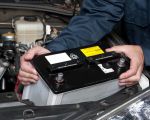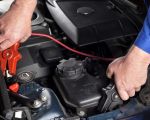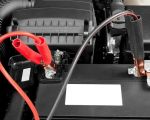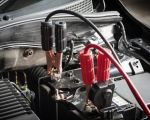What Tools Do I Need for a Car Battery Replacement?
Replacing a car battery might seem like a daunting task if you've never done it before. However, with the right tools and a bit of knowledge, it's a manageable DIY job that can save you money and time. Whether you're stranded with a dead battery or just looking to replace an old one before it fails, understanding what tools are essential for the job can make the process smoother and safer. In this article, I'll walk you through the tools you'll need for a car battery replacement and provide some helpful tips to ensure the job is done right.

NTB-National Tire & Battery
6315 Prentiss School Dr, Canal Winchester, OH 43110, USA
1. The Essential Tools for Replacing a Car Battery
The first step in replacing a car battery is having the right tools. Here’s a list of the most common tools you'll need:
- Wrench or Socket Set – The most essential tool to remove the battery cables from the battery terminals. You may need a wrench with a 10mm or 13mm socket depending on your car’s make and model.
- Battery Terminal Puller – This tool helps you remove the battery cables from the terminals without causing damage.
- Gloves – Protect your hands from battery acid and grease by wearing gloves. They’ll also help you maintain a better grip on the battery and tools.
- Safety Glasses – Battery acid can be hazardous to your eyes, so wearing safety glasses is important for protection.
- Ratchet Wrench – A ratchet wrench gives you extra leverage when tightening or loosening bolts that are stubborn or too tight.
- Battery Cleaner or Baking Soda Solution – Over time, corrosion can build up on the battery terminals, and cleaning it off will help ensure a proper connection. A simple solution of baking soda and water works well for this.
- New Car Battery – This is obviously essential! Ensure that the replacement battery matches your vehicle’s specifications (size, voltage, and type).
Now that we have the tools ready, let’s dive into how to use them to replace the car battery safely.

Pep Boys
1200 W Washington Blvd, Los Angeles, CA 90007, USA
2. How to Remove the Old Battery
The first step in replacing a car battery is to turn off your car and ensure that it is on a flat surface with the parking brake engaged. It’s also a good idea to wear your gloves and safety glasses at this point to protect yourself from potential hazards.
Before removing the old battery, make sure to disconnect the negative terminal first. Using your wrench or socket set, loosen the bolt on the negative terminal (usually marked with a minus sign). Once it’s loose, use a battery terminal puller to carefully remove the cable from the terminal.
Next, disconnect the positive terminal (marked with a plus sign) using the same method. It’s important to always remove the negative terminal first and reconnect it last to avoid creating a spark while working with the battery.
Once the cables are disconnected, carefully remove any fasteners or straps that are holding the battery in place. Be sure to lift the old battery out slowly and place it in a safe location.
3. Preparing the New Battery
Before installing the new battery, it’s important to clean the battery tray and terminals. Over time, dirt, grime, and even battery acid can build up in the tray and around the battery terminals. Use a baking soda solution (mixing baking soda with water) or a dedicated battery terminal cleaner to scrub away any corrosion. Once the area is clean, wipe everything dry with a clean rag.
Next, ensure that your new battery is the correct size for your vehicle and that it is fully charged. If your new battery is not already charged, you may need to use a battery charger to bring it to a sufficient voltage before installing it in your vehicle.
4. Installing the New Battery
Now, it’s time to install the new battery. Carefully place the new battery into the tray, ensuring that the terminals are positioned in the same direction as the old battery. Reattach any fasteners or straps to secure the battery in place.
Once the battery is secure, reconnect the positive terminal first, followed by the negative terminal. Use your wrench or socket set to tighten the bolts on the terminals. Make sure they are tight enough to form a secure connection, but be cautious not to overtighten and risk damaging the battery terminals.
5. Checking and Testing the Installation
After connecting the battery, double-check that all connections are tight and secure. Now is the time to test the battery and ensure everything is working as it should. Start your car and observe if the dashboard lights come on, the radio works, and other electrical components are functioning. If everything is operating properly, congratulations! You’ve successfully replaced your car battery.
If you notice any issues with starting the vehicle or the electrical components, double-check the battery connections, or seek professional assistance from a towing or automotive service company, such as Rescue & Towing.
6. Proper Disposal of the Old Battery
After replacing the battery, it’s important to dispose of the old one properly. Car batteries contain hazardous chemicals, including lead and acid, which can be harmful to the environment. Many auto parts stores and recycling centers offer free battery disposal services. Be sure to take your old battery to a certified recycling center to ensure it’s disposed of in an environmentally friendly manner.
7. When to Seek Professional Help
While replacing a car battery is a straightforward task for those with the right tools and experience, there may be situations where professional help is necessary. For example, if you encounter issues with the battery tray or if your vehicle’s electrical system is malfunctioning, it’s best to call a professional to avoid causing further damage.
If you're unsure about handling the tools or don’t feel comfortable performing the battery replacement yourself, don’t hesitate to contact a professional roadside assistance service or towing company. Many companies, like Rescue & Towing, offer emergency battery replacement services on-site, saving you time and effort.



























